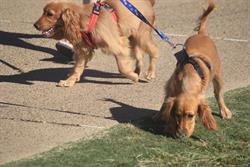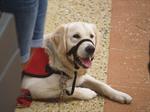Study Dog Psychology, Behaviour and Management - Change the Lives of Dogs and Their Owners
When we really understand how dogs think, we can recognise triggers that affect their behaviour and then start to train them.
This course is an ideal starting point for becoming a skilled and effective dog trainer. And it is ideal for people working in the canine professions.
- Understand canine psychology and how dogs think.
- Understand the principles of dog training through determining their psychology.
- Apply that knowledge to practical training and behavioural management from the beginning of the course.
- An understanding of canine psychology and behaviour is vitally important for anyone who works with dogs or keeps them as a companion animal.
This course is suitable for anyone who is interested in dogs and the way they behave.
For example -
- dog owners
- dog trainers
- veterinarians
- veterinary assistants
- dog rehabilitation workers
- dog behaviourists
- dog care workers
- boarding kennel workers
- pet shop assistants
- dog groomers
- dog walkers
- dog re-homing workers and much more...
 Understanding how the domesticated dog has developed anatomically and physiologically from its wild counterpart, the wolf, will helps us to understand behaviours commonly seen in today’s domesticated dog and therefore allows us to provide an environment in which the dog remains a happy and healthy companion.
Understanding how the domesticated dog has developed anatomically and physiologically from its wild counterpart, the wolf, will helps us to understand behaviours commonly seen in today’s domesticated dog and therefore allows us to provide an environment in which the dog remains a happy and healthy companion.
Lesson Structure
There are 9 lessons in this course:
-
Nature and Scope of Canine Psychology
-
A brief history of the canine evolution
-
Self-domestication
-
Canine industries
-
Canine Senses
-
Understanding canine communication
-
Sight
-
Body Language
-
Smell
-
Sound
-
Elimination Postures
-
Understanding Natural Canine Behaviour
-
Social Structure
-
Social Behaviour
-
Aggression
-
Clinical Problems
-
Biological Rhythms
-
Sleep
-
Sexual Behaviour
-
Maternal Behaviour
-
Parturition
-
Suckling and Weaning
-
Eating and Drinking
-
Canine Behavioural Development
-
Nurture
-
Sensitive Periods
-
Neurological Development
-
Canine Temperament Testing
-
How Breeds Differ
-
Canine Behavioural Disorders
-
Attention Seeking Behaviour
-
Excessive barking
-
Chewing
-
Running away
-
Chasing moving objects
-
Begging
-
Digging
-
Separation anxiety
-
Aggression
-
Phobias
-
Excessive compulsive disorders
-
Cognitive Dysfunction
-
Calming a dog
-
Basic Dog Training
-
Forming habits
-
Conditioning
-
Classical Conditioning
-
Operant Conditioning
-
Socialisation
-
House training
-
The use of visual signals
-
The use of voice commands
-
The use of training aids
-
Dog Obedience Training
-
Practical Training Techniques
-
Recall
-
Sit
-
Stand
-
Drop
-
Leave
-
Down
-
Stay
-
Heel
-
Seek
-
Retrieve
-
Bark on Signal
-
Controlling a Dogs Movement
-
Territorial nature of dogs
-
Fencing
-
Dog doors
-
Kennels
-
Exercise requirements
-
Socialisation requirements
-
Walking on a lead/leash
-
Electronic barriers
-
Microchips
-
Pet Registration and Licensing
-
Controlling Killing Wildlife
-
Training Working Dogs
-
Training for scent discrimination or substance detection
-
Training for retrieving
-
Guarding
-
Hearing dogs
-
Herding
-
Tracking
-
Controlling attacks on animals and people
Aims
-
Describe how canine animals think and discuss the relevance of understanding canine psychology to people.
-
Explain how canine animals communicate and formulate an understanding of possible ways that a human may communicate with a dog.
-
Understand behaviours that are natural and predictable in canines and learn to recognise and understand signals that dogs give.
-
Explain how dogs develop behavioural characteristics throughout stages of their life.
-
Describe commonly occurring behavioural problems in dogs.
-
Develop a program for training a new pet dog when it is brought into a household.
-
Explain how to train a dog to perform predetermined actions upon command.
-
Describe how the movement of dogs can be controlled, both through training and other methods.
-
Describe how dogs can be trained to perform tasks required as a working dog, including a sheep dog, tracking dog, blind dog or substance detection dog.
What You Will Do
-
Describe how canine animals think and discuss the relevance of understanding canine psychology to people.
-
Explain how canine animals communicate and formulate an understanding of possible ways that a human may communicate with a dog.
-
Understand behaviours that are natural and predictable in canines and learn to recognise and understand signals that dogs give.
-
Explain how dogs develop behavioural characteristics throughout stages of their life.
-
Describe commonly occurring behavioural problems in dogs.
-
Develop a program for training a new pet dog when it is brought into a household.
-
Explain how to train a dog to perform predetermined actions upon command.
-
Describe how the movement of dogs can be controlled, both through training and other methods.
-
Describe how dogs can be trained to perform tasks required as a working dog, including a sheep dog, tracking dog, blind dog or substance detection dog.
Improve your understanding of how dogs think
 Dogs may not be able to speak and tell you how they feel, but there are many ways that we can gauge their feelings and build an understanding of the mind of an individual animal.
Dogs may not be able to speak and tell you how they feel, but there are many ways that we can gauge their feelings and build an understanding of the mind of an individual animal.
Here are some examples of the types of things you can learn throughout this course. As your understanding of dog psychology expands, throughout your studies, your ability to understand and better respond to canines, will strengthen and deepen, providing a solid foundation for better training and managing dogs.
The Tail
Many people associate a dog wagging its tail with friendliness. However, this is not generally the case. If it is held straight up or curled over at the tip and moving quickly from side to side in small rapid movements it is a sign of arousal. Other tail signals include:
- relaxed tail – dog is relaxed and comfortable
- light wagging – welcoming
- broad circle wagging – dog is interested
- slow wagging – doesn’t quite understand what you are trying to teach him (e.g. in training)
- fast wagging – excited
- hanging horizontal but relaxed – the dog is interested in something, attentive
- hanging horizontal but stiff – confrontational (such as confronting an intruder)
- tail between legs – submission or fear
- tail raised and slowly moving – dog is on guard
- upright tail - sign of dominance
- upright tail curled over at end – demonstrates trust and self-confidence
Chewing
Chewing is a natural action for all dogs; however chewing can quickly become a problem if your dog causes destruction.
The most common reasons dogs chew are:
- teething
- boredom and/or excess energy
- anxiety
- curiosity (especially puppies)
Encourage your dog to chew on the right things by providing plenty of chew toys. Keep personal items away from your dog. When you are not home, keep your dog crated or confined to an area where less destruction can be caused. If you catch your dog chewing the wrong thing, quickly correct him with a sharp noise. Then, replace the item with a chew toy. One of the most important things you can do is make sure your dog gets plenty of exercise.

Working with Dogs
Dogs fill a variety of roles in our current human society. Working dogs can carry out a variety of jobs from herding sheep, helping the lives of disabled and blind people, to seeking out and detecting explosives and drugs.
In most countries around the world, the most common role of domesticated dogs is as a companion animal to humans. There are a wide variety of ancillary industries that rely on this companion animal market.
Some examples include:
- breeding enterprises
- grooming enterprises
- training enterprises
- boarding or kennel enterprises
- walking and pet sitting
- pet shops sell a range of products and equipment
- canine behaviour therapists
- complimentary medicines and therapies
Train and Manage Dogs
- Do you want to understand more about canine psychology?
- Do you want to know what makes dog behave the way they do?
- Do you want to learn how to help dogs with their behavioural difficulties?
- Do you want to improve your job and business opportunities in working with dogs?
Then this is the course for you!
Enrol Today
Enrol to develop your own research and reading into the field of dog training and management. Use your tutors knowledge and expertise as much or as a little as you need. Our highly qualified and experienced tutors are helpful and friendly ... they have all been in your shoes, aiming for a goal.
You can enrol
on the course now, but if you have any questions about the content of
the course or studying with ACS, then please get in touch with us today
- use our FREE COURSE COUNSELLING SERVICE to get in touch with our expert tutors. They will be pleased to help you!
